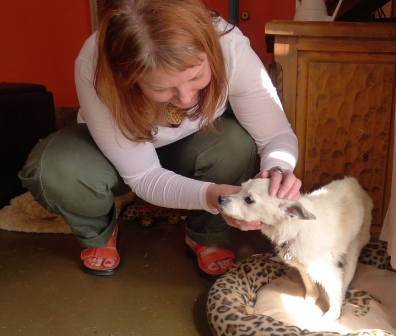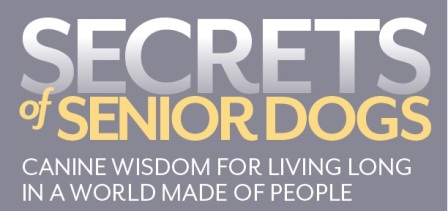
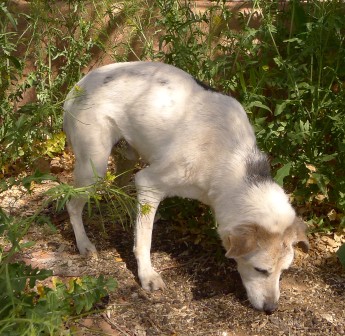
OLD
DOGS, IT TURNS OUT, act a lot like old humans—the same deafness,
grumpiness, and forgetfulness, not to mention incontinence. And since we
are a society that dreads all signs of aging, it’s no surprise that old
dogs get disrespected, disliked, and discarded. That makes it even
harder to get them adopted out of shelters, where they can’t survive for
long.
“I just can’t imagine being old and in a shelter,” says Tammy
Fiebelkorn, who has adopted older rescues for many years. When she reads
about a senior found on the street, her heart melts at the thought of
being blind, deaf, arthritic—and then abandoned. Shelter workers know
the heartbreaking, routine scenario of a dog turned in for the crime of
growing old. Ulla Pederson, who founded the kindred Spirits sanctuary in
Cerrillos specifically for older animals (“On Earth as It Is in
Heaven”), says the problem is not that animals grow old—it’s
that we live in a “throwaway” culture that overvalues the new.
Dogs, like people, are living longer these days, thanks to advances in
medicine and preventive care. It’s not unusual to find dogs happily
going about their routines at 12 or 13. In fact, New Mexico last year
ranked No. 4 among states where dogs live the longest, according to a
study by Banfield Pet Hospitals. (Mississippi was the worst, with a life
expectancy of 10.1 years; South Dakota the best at 12.4.)
Still, it’s not every day that you come across a dog who has passed the 16-year mark. Such a dog would, in human years, be the equivalent of 80 (for a small dog) to 115 (for a Great Dane). Size matters a lot when it comes to canine longevity. For reasons not completely understood, small breeds live longer, possibly because large breeds grow so quickly in their first two years of life, it puts stress on their organs and skeletons.
The longest-lived breeds are nearly all small: Chihuahua, Lhasa Apso, Beagle, Maltese, Pomeranian, Boston Terrier, Poodle, Dachshund, Miniature Schnauzer, and Pug. These dogs routinely live to 14 or older. But if you are partial to Irish Wolfhounds, Great Danes, Bernese Mountain Dogs, Saint Bernards, or Dogues de Bordeaux, be prepared to say goodbye after six or seven years. Naturally, some smaller breeds (like toys) have congenital issues that shorten their life spans, while some larger breeds are quite hardy. Australian Cattle dogs are among the longest lived for their size.
Beyond genetics, dogs tend to succumb to the same maladies that we do. Cancer kills half of them over the age of 10, while being overweight will shorten a dog’s life by an average of 1.8 years. Happily, not many dogs smoke, drink, or drive fast. Dogs differ from people in other respects as well.
Arthritis and joint degeneration can impact their quality of life quite early, and after age 10, almost universally. “I see that in so many animals—all breeds, all sizes, starting as young as 6,” says Holly Meuser, associate veterinarian at Acequia Animal Hospital. With loss of mobility come issues like pain, potty accidents, and depression from not being able to hang with the pack.
That’s why moderation is key when it comes to dog activity. Working dogs, jogging companions, or those who compete in agility can get arthritis very early, Meuser says. Being a couch potato is no better—it leads to overweight and loss of muscle tone. “Moderation is best—keeping them at healthy weights, active but not overdoing it.”
Surprisingly, dental problems make up a serious, epidemic cause of health problems for dogs in later life. That’s because bleeding gums caused by plaque and tartar eventually let bacteria and toxins enter the blood stream, damaging the heart and kidneys. “Dental hygiene is really lacking in pet ownership,” Meuser said. “You have to get them cleaned every once in a while.”
Most dog owners would rather express their solicitude with food, toys, and supplements than tooth-brushing. But “dogs don’t need the best of everything to live a long life,” Meuser says. “The best food is not going to make a dog live longer.” While some people swear by a raw diet, or homemade recipes, or herbal formulas, the cost is prohibitive for most. A good-quality kibble (since canned food worsens dental problems)—one with high protein and low carbohydrates, in the form of vegetables rather than grain—should be enough for most dogs to fulfill their genetic destiny.
Keeping dogs mentally stimulated does help keep them young, since their brains age just as ours do, a process that can be slowed by staying engaged. “Get older dogs out there, even if it’s just down the block or for a car ride, because they can get depressed,” Meuser said.
It’s important to remember too that human love and care hardly comprise the canine fountain of youth. In fact, Meuser has found that dogs who are wary tend to live a bit longer than people-pleasers. This was certainly confirmed by the distinguished dogs we interviewed, who have all stopped living to see their humans wag and grin. It appears that a large part of wisdom, in dog terms, means knowing when to put your paw down, stake your spot on the couch, and refuse to go fetch that damn ball.
Frasier
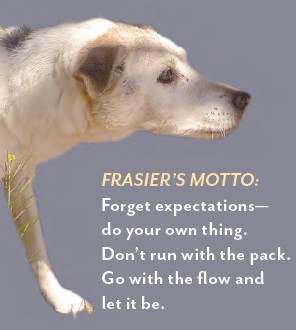
BREED: Jack Russell Terrier
AGE: 19
Frasier’s humans joke that he was a “bargain basement” dog, the last of a litter offered at half price by a breeder in Fresno, Calif. In March 1995, Ennio Garcia-Miera (now a Corrales councilman) was looking for a companion for his sons, which he found in a rambunctious, out-of-control energetic Jack Russell Terrier puppy.
Frasier loved to chase and be chased. Everyone remembers the time he got loose in a supermarket, and what a commotion it was to catch him. But the boys loved the pup who helped the family hang together through tough times. When the brothers went off to UNM, Frasier and their other dog, Chata, went along. But it’s not easy going to college with two dogs. The day after their father’s partner moved to Corrales, the boys dropped off the two dogs.
It was 2004, Ed Goodman recalls, and Frasier was 9. Along with Ed’s dog, Homer, they made three dogs and one human in a big house in Corrales. Ennio was still in Boston.
Ed, who writes “Ask a Lawyer” for The Bosque Beast, was starting to grow a soft spot for dogs, and soon developed the affliction known as “foster failure.” He would rescue dogs and fail to give them up. Before long, Frasier was living with a half dozen canines and two humans, and that house didn’t seem so big anymore.
Chata and Homer both died at the age of 13, though they were younger than Frasier. Other dogs came along to replace them. There are still seven dogs in the house, plus the turkeys and the parrot. But Frasier has learned to ignore them all.
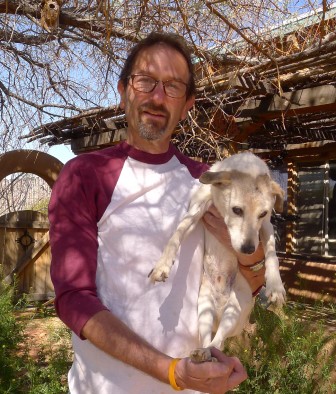
“He’s
a little demented,” Ed admits as we watch Frasier walk in circles,
sniffing the floor. “Most of the day he’s focused on searching for
nonexistent crumbs.”
Though he used to like curling up with a buddy, Frasier keeps to
himself these days on his bed in the living room. It doesn’t help that
everyone is bigger than he is, and two of the dogs are blind. “They tend
to bump into him,” Ed says.
Also, Frasier can’t quite make it out the doggie door, and probably
wouldn’t bother if he could. So humans are always mopping up his messes.
Yelling would be in vain, since Frasier is deaf. “He lives in his own
world,” Ed sighs.
But Ennio’s sons are thrilled to see the old boy have his moment of
fame, especially since he was named after the sitcom character— if
you’re old enough to remember sitcoms.
Californian by birth, Frasier has never needed fad diets, yoga, or
therapy. “He’s just a really happy dog,” says Ed. “He’s never been
aggressive, loves people. He’s always been fairly mellow— for a Jack
Russell.”
Murphy

Breed: Mixed
Age: 17
Murphy’s life began badly, because he turned up at the shelter “as frightened as any animal you will ever see,” according to his human, Teri Pierce.
Rio Rancho Animal Control thought he was 2 or 3, and clearly had been abused. The man who brought him in said the 16-pound dog was named Spike, recalls Teri, rolling her eyes. “Spike” was so scared, he came in her house and pooped on the floor, then went out in the yard and refused to come in.
It was 1997. Teri had recently moved to Corrales from Chicago, and as part of her total life change had started fostering homeless dogs. Murphy was No. 3.
That first day, she and her cat Sophie sat outside until he finally came in, ate his dinner, and jumped up on the couch. “He’s been there ever since,” she says.
Murphy looks up vaguely, 17 years later. He rarely leaves the sofa anymore unless Teri picks him up to go out, and then he hobbles on arthritic back legs, a gait familiar in old men. His memory is shot, so he has no recollection of the days when he arrived here totally “shut down,” and would not set paw out of the house.
The solution came where Teri herself finds it—hiking in the hills. In the years since they first started hiking, Murphy and Teri have climbed mountains together, including Wheeler Peak. Murphy may have short legs, but Teri always tired before he did. He would go 20 miles in a heartbeat.
To get over his fear of humans, Murphy tagged along whenever Teri left her home office to meet with attorneys for whom she did contract legal work. He became quite popular at board meetings, she said.
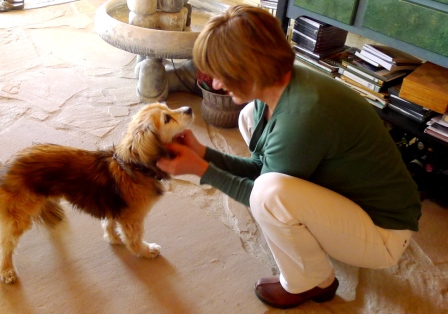
Touching
proof of his transformation came about 18 months ago, when Teri
fostered a dog from Roswell who was “another Murphy—terrified and shut
down.” Putting them together had a magical effect, she said. At a
certain moment, the scared little dog suddenly decided the world was
safe, and trotted off after Murphy down the ditch bank.
Murphy was going strong until a year ago, when he had a stroke. Now he
sometimes forgets where he is. His kidneys are going, and his hikes end
at the mailbox. “His world got smaller and smaller,” says Teri, “and
now it’s just the sofa.” But he’s not in pain, and he seems happy. He
still sniffs a stranger politely and offers a sweet kiss.
“I was terrified of the idea that I’d have to put Murphy down someday,
but taking care of him, you go on the journey with them and see how it
has to happen,” Teri says. It’s given her perspective on aging, she
says, “because as a society we are so in denial about it.” She is calm
now about letting Murphy lead the way on his final hike.
“He has taught me a lot more than I ever thought to teach him.”
Desta

Breed: Mixed
Age: 18
Desta is a living testament to the virtues of clean living. Since the age of 2, when Jennifer Verhoog got her, she has benefitted from every natural therapy known to her human, a doctor of Oriental Medicine and half a dozen alternative treatment regimens.
Desta means “happy” in Ethiopian, and the dog has at times been overly happy to run in the street, run away, run wild. She originally belonged to an Ethiopian woman who rescued her in Portales. Through a series of circumstances, she ended up being Jennifer’s dog in the late 1990s, moving with her to California, Colorado, Chicago, and New Mexico.
“I confess it took me a while to fall in love with her,” says Jenn, a dog addict who once had 16 of them with her sister, another foster failure. Not only was Desta an only dog in the late 1990s, she didn’t even like being touched—a challenging situation for a healer whose practice consisted of touch therapies, which she still practices on her chickens.
One day, Desta managed to get herself hit by cars twice in a single mad dash. “She was in so much pain, she finally let me do acupuncture, T-Touch, herbs,” Jenn says. In fact, Desta has hardly ever experienced conventional veterinary medicine or commercially prepared foods, thriving instead on a variety of holistic, high-end regimens. “She’s been an experiment,” Jenn admits.
Anyone would call this experiment a success, from the looks of it. Not only does Desta wrestle with the two young males she lives with, she has bursts of energy that find her tearing around the house and yard, arthritis and all. Even better, she now likes being touched, and will lean her head sweetly on her human.
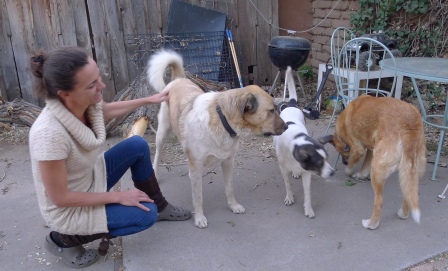
That’s not to say Desta doesn’t act old. She’s almost completely deaf,
and about 70 percent blind. Like other old dogs, she will walk in
circles or wander off and forget where she’s going. But you would never
guess the old girl is 18.
“I try to challenge her, keep her stimulated,” says Jenn, who will
move her food dish, or physically push Desta to and fro to practice
balance and keep her engaged. “Her cognition, physical support
(arthritis management), and staving off cancers are the three categories
I work with her.”
A home pharmacy of herbs, supplements, and other remedies that she
calls “the duck tape drawer” (because it holds the family together)
allows Jenn to adjust Desta’s treatments according to how she is faring
from day to day. “At her age, Desta takes up a large percentage of that
drawer!”
Penny and Betty
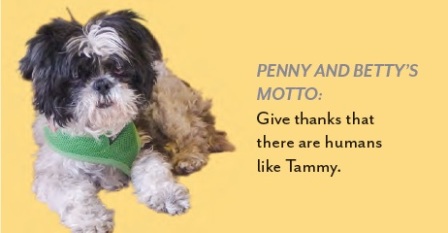
Breed: Chihuahua mix, Shih-tzu mix
Ages: 15 or 16
Not much is known about these two, since they were found, at different times, wandering the streets of Española. Considering how long an old, sick, homeless dog would last in Rio Arriba County, they clearly had been dumped.
It’s a story that Tammy Fiebelkorn knows all too well. Since she first fell for an abused shelter dog who was 14 years old, Tammy has only adopted seniors. That means she loses, on average, three of them a year. But it also has turned her into a passionate advocate for the joys of adopting old.
“They are already trained, with none of that hyper puppy energy—no barking, chewing, tearing things up.” Her dogs always end up calm and loving, though it might take a while to earn their trust. “Once they feel safe—Penny is a good example. She is always in your lap or next to you. I think animals feel what you’re feeling, and if you think they’re old and disgusting, they feel that.
“These guys never get depressed, and live nice long lives.”
The drawback, of course, is their health. Tammy’s dogs invariably have enlarged hearts, plus reduced vision, hearing, mobility, and sometimes cancer. The common thread is that veterinarians usually tell her the dogs have a few weeks or months left, and they live for years. “Good food, a little exercise, and always feeling safe and secure allows them to live longer.”
Without people like Tammy, old dogs have almost no chance of making it out of a shelter alive. When she decided to adopt Betty, she was met by a shelter worker who drove halfway from Española to meet her, she was so clearly the dog’s last hope. Old, incontinent, with rotten teeth and a heart murmur, nearly blind—who is going to adopt an animal like that? But it’s not out of pity that Tammy rescues them. She bristles at the very idea.
“I don’t feel sorry for them! These girls would have been put to sleep, and that’s a shame. But they’re smart and capable—I have no reason to feel sorry for them. They’re fun to be around.
“There are little things to manage, like tinkling on the floor. So get some pee pads! It’s so little compared to what they give you.”

